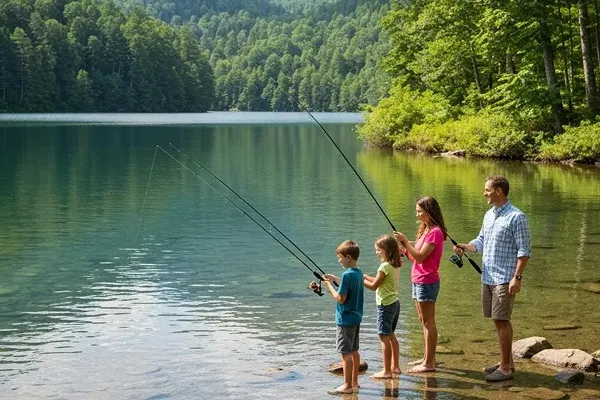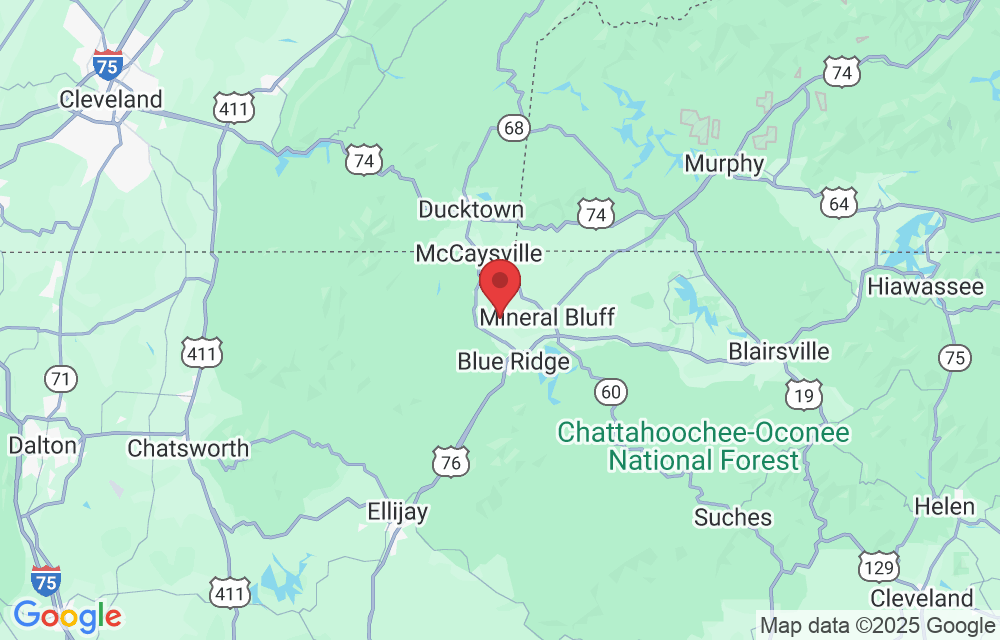
Family-Friendly Trout and Bass Fishing Guides
Families searching for memorable outdoor adventures will find Blue Ridge, Georgia, a haven where clear mountain waters teem with trout and bass. This guide previews the best family fishing spots, profiles local fish species, outlines preparation tips and regulations, and explains how a stay at Bigfoot Cabin enhances your experience. By exploring Toccoa River, Cooper Creek, Rock Creek, and Lake Blue Ridge, identifying Rainbow, Brown, and Brook trout as well as bass and walleye, and mastering gear, safety, and licensing, parents can plan a seamless, kid-friendly angling getaway.
What Are the Best Family Fishing Spots in Blue Ridge, Georgia?
Blue Ridge offers diverse waters—rivers, creeks, hatcheries, and a scenic lake—each suited to parents with children aged 5–18. These locations combine gentle currents, regular trout stocking, and easy shoreline access so families can enjoy successful outings together.
Toccoa River: Tailwater sections below Lake Blue Ridge Dam provide cool flows and accessible wading for young anglers.
Cooper Creek: Regular trout stocking near the wildlife management area ensures reliable catches.
Rock Creek & Hatchery: The Chattahoochee National Fish Hatchery guarantees sightings and educational tours.
Lake Blue Ridge: Bass and walleye fishing around boat ramps and piers adds variety for all skill levels.
Families can pick a spot that matches kids’ confidence level and explore multiple waters over the same weekend.
Which Sections of the Toccoa River Are Ideal for Family Trout Fishing?
Cool, clear, dam-controlled flows in the Upper Tailwater and Horseshoe Bend stretch create shallow pools where Rainbow and Brown trout congregate, offering visual thrill and steady action for novice anglers.
Tammen Park – Paved access, picnic tables, unobstructed shoals.
Curtis Switch – Wide banks and gentle currents for safe wading.
Horseshoe Bend Park – Multiple fishing platforms within casting distance of deep runs.
Deep Hole Rec Area – Natural pools ideal for casting practice and small-group outings.
These access points balance safety and catch opportunities, making them perfect preludes to exploring Cooper Creek’s stocked waters.
Why Is Cooper Creek Perfect for Beginner and Kids’ Fishing?

Cooper Creek’s combination of regular trout stocking and easily banked pools creates a reliable environment where young anglers can land fish with basic spin-casting gear, boosting confidence and enthusiasm.
Stocked with Rainbow and Brown trout weekly during spring and fall seasons
Gravel entry points for secure footing and quick bait changes
Nearby campgrounds and picnic areas for all-day family fun
This consistency sets the stage for a hands-on educational visit to the Rock Creek hatchery.
How Does Rock Creek and the Chattahoochee National Fish Hatchery Enhance Family Fishing?
At Rock Creek, the adjacent hatchery releases thousands of juvenile rainbow trout into the stream, ensuring ample stocking density and offering guided tours that engage kids in conservation lessons.
Educational Tours – Behind-the-scenes hatchery visits explain spawning and rearing.
Guaranteed Sightings – High survival rates translate to frequent bites.
On-Site Parking – Short walks from the hatchery to fishing platforms reduce fatigue.
After observing fish culture, families can immediately apply lessons by casting live fingerlings upstream.
Chattahoochee Forest National Fish Hatchery and Trout Stocking in North Georgia
The Chattahoochee Forest National Fish Hatchery, administered by the U.S. Fish & Wildlife Service, produces approximately one million rainbow, brook, and brown trout annually. These fish are stocked into various public waters across North Georgia, including Rock Creek, in cooperation with the Georgia Department of Natural Resources. The hatchery also offers educational tours, explaining the process of fish propagation and conservation. Cooper Creek and the Toccoa River are also regularly stocked by the Georgia Wildlife Resources Division.
This citation verifies the role of the Chattahoochee National Fish Hatchery in stocking Rock Creek, the regular stocking of Cooper Creek, and the presence of stocked trout in the Toccoa River, as highlighted in the article.
Fishing Opportunities and Species in Lake Blue Ridge
Lake Blue Ridge, a 3,290-acre reservoir, is home to various fish species including Smallmouth Bass, Largemouth Bass (Spotted Bass), and Walleye. Walleye fishing is often most productive in the spring and fall, particularly at night along rocky points and shorelines. Smallmouth bass are typically found off rocky points, ledges, and shallow humps.
This research confirms the types of bass and walleye species found in Lake Blue Ridge and their preferred habitats, aligning with the fishing opportunities described in the article.
Whether trolling from a boat or casting from the dock, families find diverse techniques and fish behaviors to explore before moving on to species identification.
What Types of Fish Can You Catch in Blue Ridge, Georgia?
North Georgia’s waters nurture trout in freestone streams and bass and walleye in impoundments, delivering a well-rounded angling experience that accommodates different skill sets.
How to Identify Rainbow, Brown, and Brook Trout in North Georgia Waters?
A simple trout identification chart helps families distinguish species by color patterns, spots, and preferred stream microhabitats:
What Bass and Walleye Species Are Found in Lake Blue Ridge?
Lake Blue Ridge supports:
Smallmouth Bass – Prefers rocky points and current breaks.
Largemouth Bass – Roams shallow lily pads and fallen timber.
Walleye – Active during low-light periods near ledges and humps.
Families can alternate between spin-casting lighter lures for bass and jigging minnows for walleye to maintain excitement throughout the day.
Which Fish Are Most Suitable for Kids to Catch?
Young anglers often succeed with:
Rainbow Trout – Stocked in shallow pools for easy landings.
Bluegill and Bream – Readily bite corn or worms in calm creek bends.
Smallmouth Bass – Slower strikes teach patience and fight control.
Targeting these species ensures frequent action, reinforcing positive experiences and skill development.
How Can Families Prepare for a Successful Fishing Trip in Blue Ridge?
Effective preparation combines the right gear, safety measures, and timing to maximize catch rates and comfort for parents and kids alike.
What Essential Fishing Gear and Techniques Are Best for Kids?
Providing lightweight, easy-cast equipment and fun baits ensures early success:
Spincast Rods with Kid-Size Reels – Reduces tangle frustration.
Foam Bobbers and Live Worms – Simplifies bite detection and bait handling.
Basic Fly Rods (2–4 wt) – Introduces fly casting with minimal line tension.
Equipping youngsters appropriately transitions into safe practices and licensing awareness.
What Are the Safety Tips and Regulations for Family Fishing in Blue Ridge?
Always wear life jackets when wading or on boats.
Respect posted private land boundaries and catch limits.
Practice catch-and-release for wild trout populations.
Observing these principles lays the groundwork for legal compliance and ecological stewardship.
When Is the Best Time to Fish in Blue Ridge’s Trout and Bass Waters?
Timing trips around seasonal patterns optimizes success:
Spring (March–May) – Peak trout stocking and active bass spawning.
Summer (June–August) – Morning and evening trout feeding at tailwaters.
Fall (September–November) – Cooler water boosts trout activity and bass fall feeding.
Aligning outings with these windows enhances catch rates and family enjoyment.
Where Can You Find Fishing License and Regulation Information for Blue Ridge, Georgia?
Understanding licensing requirements and area-specific rules ensures compliance and preserves quality angling experiences.
Who Needs a Fishing License and Trout Stamp in Fannin County?
In Georgia, anglers aged 16 and over must carry a valid state fishing license; trout waters additionally require a $5 trout stamp. Children under 16 fish free with supervising adults.
Georgia Fishing Licenses and Trout Stamps
In Georgia, individuals aged 16 and older are required to possess a valid fishing license for both fresh and saltwater fishing. Additionally, a separate trout license is necessary for those fishing in designated mountain trout waters. These licenses can be conveniently purchased online through the Georgia Wildlife Resources Division website or from various authorized local agents.
This information directly supports the article's section on who needs a fishing license and trout stamp in Fannin County and how to obtain them, ensuring compliance with state regulations.
What Are the Key Fishing Regulations Families Should Know?
Daily Catch Limits – Typically five trout per licensed angler.
Size Restrictions – Minimum length requirements vary by species.
Area Closures – Observe seasonal closures for wildlife protection.
These rules safeguard fish populations and outdoor access for future generations.
How to Obtain a Georgia Fishing License for Your Family Trip?
Licenses and trout stamps can be purchased online at Georgia’s Wildlife Resources Division website or in person at authorized retailers such as outdoor outfitters and bait shops.
Securing credentials before arrival removes last-minute hassles and lets families focus on fishing fun.
How Does Staying at Bigfoot Cabin Enhance Your Blue Ridge Fishing Experience?

Bigfoot Cabin Blue Ridge serves as a convenient, comfortable basecamp where families can relax between river and lake adventures, benefiting from expert local knowledge and tailored amenities.
What Family-Friendly Amenities Support a Fishing Vacation at Bigfoot Cabin?
Outdoor Fish Cleaning Station – Keeps gear tidy and dinner prep simple.
Kids’ Game Room and Yard – Offers downtime entertainment after fishing.
Covered Gear Storage – Protects rods, nets, and tackle from weather.
How Close Is Bigfoot Cabin to Top Blue Ridge Fishing Locations?
What Local Fishing Tips and Insider Knowledge Does Bigfoot Cabin Provide?
Guests receive curated advice on:
Optimal Bait Choices – Seasonal hatch guides for trout nymphs and baitfish patterns.
Hidden Access Points – Under-the-radar creek inlets away from crowds.
Peak Hatch Schedules – Timing outings for mayfly and caddisfly emergences.
Leveraging these insider insights amplifies catch success and deepens appreciation for North Georgia’s aquatic ecosystems.
Families eager to blend quality fishing with cozy accommodations will find Bigfoot Cabin a strategic launchpad for exploring Blue Ridge’s trout streams and bass waters. Book early to secure dates during prime seasons and create lasting memories on Georgia’s most family-friendly fishing playground.


